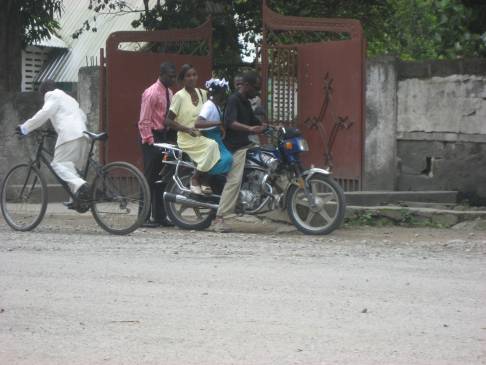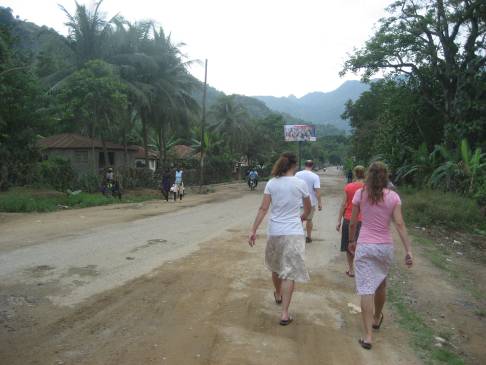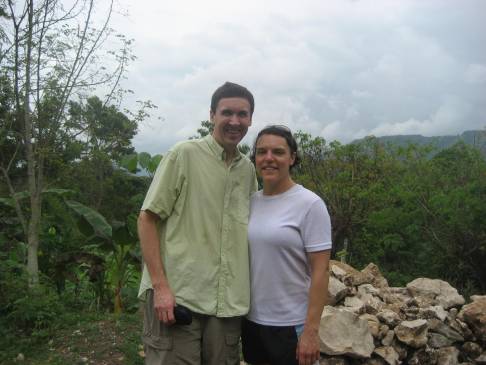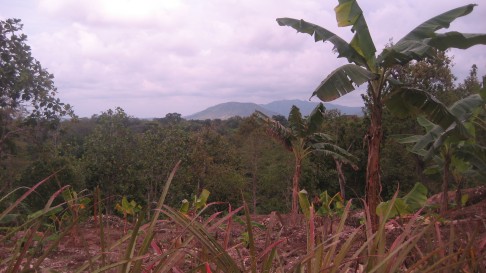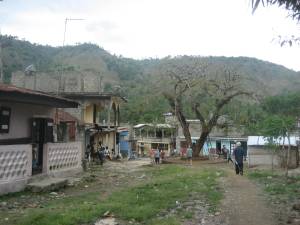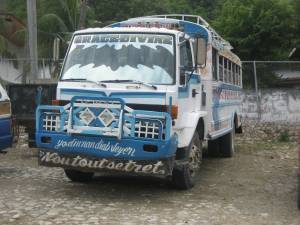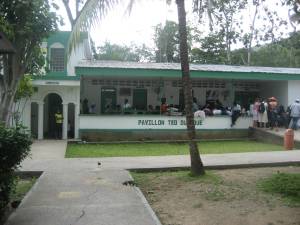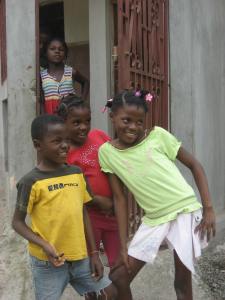Being here on my own floating between teams and projects has been fun. It’s amazing to see how friendly people are throughout town. Rather than being accosted frequently by pushy vendors, I have seen more of the regular life day-to-day living. I feel a little like Belle from Beauty and the Beast greeting people with “Bonjour, Bonjour, Bonjour, Bonjour, Bonjour…” through town. But people are so nice–greeting me back, saying “thank you very much,” “you’re very nice,” “you’re so pretty,” etc.
Monday I finally had a chance to spend time at the hospital. It was amazing to see both urology and ortho cases. I finally had an opportunity to see John at work! Jeff and Hank were awesome to let me watch their surgeries and talk me through each one. It was cool to see Dave and John explain their anesthesia machines and roles, as well. I also apparently hit it off with the nurses and nursing students, too. We created our own language between Kreole, French, and English. The translators were interested, too.
Monday I also taught Dr. Previl’s daughters, Sarah (9) and Jade, (5). They are cute and Sarah’s English is really good, but I feel a little conflicted about teaching the hospital CEO’s privileged children (who don’t even speak Kreole).
And I had a nice visit with Cesar, the young artist who lives on the loop and Donni and I visited with on Easter Sunday. I really wanted to buy a painting from him because he’s a sweet guy and because I feel his artwork is the most original that we’ve seen here. I tried to convey to him why we like his work so much and that I hope he can help inspire other young artists in Milot.
Though some of the vendors and people in town can be annoying asking for money, really when you take the time to get to speak with people, they are usually nice and real. I had a wonderful banter session the other day with a few sellers–Julie, Henri, Charlotte, Serge… “How much do you want for the woman?” I said to Julie and embarrassed myself. They have all responded well to me. I really think Julie should be in charge of business in the town–Father Tijwa’s Julia is pretty solid, too. When I told Julie that she should talk to Father Tijwa and I thought she was a good businessperson, she kissed my cheek and told me she loved me.
I’ve had such wonderful conversations with folks. From long-term employees like Treasa and Oscar to short term volunteerrs like Haitian-American nurse, Jackie, and locals like Father Tijwa, people have been really open and fabulous to talk to.
Today as usual has been full. I had an awesome morning with Father Tijwa–breakfasting, practicing German for two full hours, and then meeting with the ladies from the artist workshop. That was so cool. They were very appreciative of the support that Rotary was providing and they applauded me. I applauded them. To be there during Father Tijwa’s update was really special. Father Tijwa told me that I and people like me are what are helpful here.
I’ve had good conversations with Treasa and Jackie today about their long-term perspectives. Jackie is such good resource for the CRUDEM staff. Since she knows both cultures and both medical environments, they should really be open to her suggestions. Such simple solutions yet not done–like curtains to divide in the recovery room, do not need to cost much but can help preserve a patient’s dignity. Jackie thinks that what white people observe is about 75% accurate. Yes, some people will always want something from you–and from her, too, since they view her as successful and rich now that she lives in the US–but it’s been good to see past the annoyingly aggressive vendors and to have some nicer one-on-one interactions with people who seem genuinely nice.
Probably the most appreciative people I have seen were the family across the street from the hospital who Treasa, Jackie and I visited after lunch. They are very poor and have five children–including twin girls and only a few of the kids can afford to go to school, for only part of the time. We brought coloring books, crayons, hairbands, pencils and sharpeners to the kids and they just beamed. It was a very special moment.
I spent the afternoon at the hospital, watching Jeff do a TURP, watching John and Dave work their anesthesia magic, and watching Hank deal with an arm injury from a tap tap. It was incredible to finally get to see what my husband does for a living! Suddenly intubations, propofol, the anesthesia machine…all the references made sense!
Of course John was very helpful teaching me about every step. And the TURP electric knife and camera setup is unbelievable.
I’m sorry I wasn’t there to see John do a circumcision that Jeff let him do, but it was fun to see him excited about it. It was also good to get him out of the OR a bit for a walk through the market and to town. It’s been a full schedule, and it doesn’t help to get bad news from home about a relative’s health.
Through a combination of English, French, Kreole and pantomime, the nurses, students and I have been communicating pretty well. They are super interested in everything I do. Georges was eager for my Kreole cheat sheet, and I was happy to share it.
Last night was pretty low-key, which was nice. We drank some Prestige lager and too much red wine, had a fun Tabata workout before dinner, and stayed up too late talking. This medical group of 13 has been fabulous–all of them. I will really miss the group dynamic. How often can a group of so many get together and not have one spoiled egg in the bunch? Elaine, Donni, Kelly, Jenny, Mallory, Fred, Jeff, Hank, Dave, Dave, Jim and John have been so fun to be around. They keep telling me how amazing it’s been that I’ve interacted so much with the locals and have made such a difference here, but really they are the ones who have been doing amazing work. It’s great to see their patients appreciating their work so much, as well.
4/18/12
Today has been good so far, but I’m pretty sleepy and may take a siesta soon. The day started out well with an early morning email from Rufus letting me know the Town Toyota tax passed with flying colors. After a yummy breakfast (grapefruit, bananas, spicy eggs) I did Pilates and yoga and then followed the crew up to the hospital. First I gave blood (!) and then I spent the morning in surgeries. Apparently type A is especially in demand, so I was glad I could give my A+. Later Dave W was asking about my blood type and I mentioned I was Type A. He joked, “Yeah, I know, but what about your blood type?” Ha.
This morning’s cases were fascinating to watch. I saw John intubate a guy who had prostate surgery in the US last year and whose stents have been in ever since. Jeff spent 3 hours today operating to remove the stone-ridden stents, and this was on top of the previous surgery he had earlier in the week. And this is the guy from Miami who is abusing the system. They weren’t too happy. Watching John use the glidescope to intubate was intriguing–the wonders of technology are ready at work. It looks like they’re playing video games when they use these things.
It was good to spend more time in Hank’s room, too. I was in for a femur infection case on a pretty young kid. I couldn’t believe how he just opens up so deeply and scrapes away at the bone–and then sews and staples it all up so quickly. Amazing stuff. I’d never be able to do this kind of thing at home. It’s awesome to shadow these guys.
It’s weird that the time here is winding down. We have one more afternoon and one full day and then we’re off to Florida Friday morning. Tomorrow I’ll meet and videotape Father Tijwa and hopefully the ladies (for Jeff O) and I’ll maybe try to meet again with Dr. Previl’s girls. We have a few more purchases to make and bonding at “home,” and then we’ll pay our tips and departure fees and jet on homeward. I am full of ideas, some confusion, some frustration, a whole lot of questions, wonder, appreciation, and awe at how Haiti somehow “makes it work.” I’m inspired by Father Tijwa, Jackie, Cesar, Treasa, Jeff Monda, Mike Poirier, Jen and Amy at Second Mile Ministries, Sisters Ann and Maureen, Nick and Nicki at Children of the Promise…I’ve learned what a gorgeous country Haiti is with stark, sturdy, stoic people, tropical landscape and delicious (but scarce) food–I come back with more questions than answers and the Haiti situation is daunting, but I come back carrying with me much respect and hope for Haiti.
4/19/12
A nap took me yesterday afternoon and then I wandered up to the hospital to watch Hank do a tibia repair. Donni got to scrub in and help fasten the titanium rods, which was awesome for her. When they were done working a bunch of us went on a ridge line hike to get a sweeping panoramic view of Milot, the ocean, the Great Ocean of the North, and the palace. A Haitian proverb says Haiti has one mountain after another, and the dense jungle hike reminded me of that. We climbed steeply through the canopy and above and then descended again–at various stages passing banana, coconut, pineapple, cashed, an herbal flower for tea, ferns, many wildflowers, kombo beans, mangoes, etc. I showed Father Tijwa photos of Hawaii the other day and he said it looked just like Haiti. It’s true, but with more infrastructure and less poverty.
On the way down from the mountain we stopped at a village for Dave to distribute soccer balls and jerseys that Megan at WHS had collected. It was incredible to witness the excitement these kids exhibited when given a couple of balls. I could tell how excited and proud Dave was to distribute them.
Last night after dinner (I will really miss some of the delicious food, like the spicy onion salad dressing, rice and beans, french toast and grapefruit–and Prestige lager–we sat around talking and then I rounded with the doctors and Donni. It was pretty chaotic at night mores than even the day, I think.
I checked in a little with John, too. He’s exhausted, but it’s been a rewarding experience for him and I know he already wants to return. It was cool that Dr. Previl said that our team is one of if not the best that comes down here–and that the anesthesia team is definitely the best. So cool.
Finally, though, I spent the end of the evening playing dice with Jeff, Mallory, Elaine, Kelly, Fred, and Treasa. It’s always Jeff’s ruse to get people in talking. He and I sat for a long while talking about things here–our most significant moments here (mine was giving to the family across the way; his was being with the family and dying child with John), what keeps him coming back, and the issues at hand with Haiti, the orphanages, etc.
The group ultimately also talked about animal welfare, animals as sentient beings, and where humans are on the evolutionary process and path towards extinction, what else might be out there to do us in eventually, and the fate of our planet as a whole and whether it helps to do anything to try to help.
Jeff put me on the spot a little and I told him I was mulling things over. In truth, the conversation was depressing me. I thought about it a lot during the night and then again this morning as I sat in mass with Jeff and Mallory. On the way home I shared with him that while I agree with many of the thoughts discussed, that humans probably will become extinct someday and the planet is going to pot, I still hold out hope and it makes sense to me to battling these things. I guess then it entwined with my thoughts on Haiti, helping in general, and even religion. I feel it’s very individual. I don’t need the structure of religion to tell me what to do or help. I see many problems here and at home and can become overwhelmed by them and paralyzed. Or I can choose one small focus and know I am doing some bit. What is my motivation? It just needs to get it done. And any appreciation they have and any emotional reward and gain is a happy bonus. I admire the traditions and beliefs and hope that religion can convey to some people, and I am envious sometimes of people’s organized and group faith to help them keep their hope. But I don’t subscribe to any one belief and I choose to reflect, meditate, create peace and respect and tradition in my own personal way–taking from religion and not. It is, as Jeff says, the “less bad of the options.” I see too much division and not enough community often with religion, yet when I see people like Father Tijwa and Sister Ann, I have to know absolutely that there is definite good to come from it, too.
Now we are on the verge of our last Tabata and of course today has been another fabulously filled day to round out the full trip. I had a full two hour intensive lesson again with Father Tijwa, who also spouted to me about his thoughts on corrupt government, liberation theology, and empowering communities. He stressed that it’s important to not be too radical in change–slowly things will develop into something better. He is such a sweet man, and it has been a pleasure getting to know him.
I had fun videotaping the ladies of the art workshop for some extra footage for Jeff and Oly’s production. The ladies thought it was pretty fun, too. And my last walk through town was a fun blend of greetings, produce purchasing, and photographing dogs for Teresa to document for her animal welfare projects. I then had a good conversation with Joseph the interpreter at the hospital about good quality grammar lessons for learning foreign languages, and then I visited for 45 minutes or so with the vendor, Serge, who told me all of his thoughts on the politics in Haiti, politics of the hospital, the role of American volunteers throughout Haiti post-earthquakie, the role of voodoo in the local culture, how family life is constructed here, etc. It was cool to see the looks on passing students’ faces when they saw me sitting at the vendor shop chatting away with Henri and Serge.
This afternoon I enjoyed being a sort of gopher at the hospital, helping Hank with a casting, running errands for Donni, and visiting with the nurses and translators. Everyone has enjoyed their stay and a lot of good work has been done, including 71 cases, but we are ready to go home. CRUDEM has been impressed with our group’s work, calling the medical team one of the top if not THE top team that comes down here. They also said that our anesthesia team is the best there is.
Then Donni, Hank, Dave Hyde and I had one last Tabata workout with the onlooker security guards, and we enjoyed one last meal of tomatoes, bread, spicy onion dressing, spaghetti. Now we’re chilling with my super-secret popcorn and Haitian creme cookie stash, some cassava bread and Prestige beer, and probably some rum and one last dice game. The group is collectively subdued, I’d say, glad to be done with their last cases and rounds, packing their stuff up, and getting ready for the re-entry phase to the first world.
I will miss this group a lot. I did not know many of these people, medical and Rotary members, very well at all before coming here. It has been a wonderful two-weeks of bonding. I can say firsthand that the Wenatchee medical crew is a top-notch set of individuals, professionally and personally. And I can say that despite the uphill battle that the western hemisphere’s poorest nation faces, what I see of Haiti is nothing but beauty.

